American Sabbatical 59: 12/5/96
Arcosanti
12/5.. Tempe to Flagstaff.
Happily up in the AM, the homeward bounders found themselves heading northwest, and
wondering what in the Owl was going on. As a result of a phonecall
we were headed for Flagstaff to caucus with cousins of our friends
in San Diego, and Peggy called ahead to meet with an ex-student
who is now a professor at Northern Arizona State. We were invited
to spend the night at her house. But that’s zigging when we’ve
sworn off zags. So much for idle promises.
The way led through downtown Phoenix, and enroute we flashed past
an arched and domed Moorish illusion perched high atop a sandstone
mound: a mosque? a casino? a club? Men in white trow and red jackets
were busy in the parking lot, and we wondered what sort of cult
was looking down on traffic in the morning light. The rude traffic
was whiteknuckled in the glare, without sentiment, religious or
otherwise.
The highway goes under the city’s heart and spews out north without
a pause. Retreating from the core towers, we chased dancing chunks
of styrofoam for 10 miles. Off some truckload, perhaps, the bouncing
and blowing white stuff had been eroded into circular plates,
a process we could watch as they bounded along with us. The bigger
pieces traveled farthest, and the last chunks we saw were a couple
of feet across, rolling like wheels along the stone embankments.
Playful garbage to entertain the commuters, a new urban amenity,
perhaps.
We were just as glad to escape into the desert again, after the
requisite Indian Casino on the outskirts, and the imaginary town
sites marked in surveyor’s pins. More chollas and saguaros, then
the flora changes into desert grasslands, the cacti yielded precedence
to drybrush and grasses, and the big raptors appear. We decided
to make a sidetrip to Arcosanti, the futuristic city-in-the-making
of Paulo Soleri, on the theory that an idealistic community must
have a bakery, and we needed to sup. The site is only a mile off
the highway, after all, even if we have pledged “NO MORE TOURING.”
Incorrigible.
Right away we had to question the political acumen of Soleri.
This is supposed to become a self-contained city of 5000, but
even after 30 years in-process they can’t get the state to pave
the road in? We jolted over the washboard dirt, then skidded to
a halt. Three coyotes, heads down, necks extended, were loping
through the creosote and sage parallel to the track, about 100
yards away. Heavy-coated, fat-tailed, this family of dogs was
oblivious to our presence, as they sniffed and ambled over the
brow of an arroyo, and disappeared. Delighted with the visitation,
we thought more kindly of the Italian dreamer out here in the
blowing dust.
| Arcosanti itself, approached from the desert floor above, looks
like a small space-age construction site. Some concrete arch-things,
and some glass and concrete cubes, seem almost dwarfed by the
bare-dirt parking lots, where we pulled in and stepped out into
the nagging wind. Then we heard the bells. Hundreds of bronze
and pottery bells windchimeing a skysong. And, sure enough, the
first building we enter is the bakery. With soul and belly refreshed,
even the car curmudgeon was willing to endure another tour. |
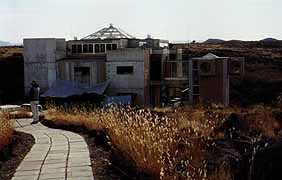
First View
|
A rosy-cheeked German lass (just out of High School) led us around
the place, starting with a scale model of the ultimate city. Peggy
will take you though the place in her turn, but here’s my snide.
Only a handful of core structures have actually been constructed
by the acolytes on site, who live communally at the master’s feet.
And beck and call, it appears. Besides intermittent building construction,
they produce bells to Soleri’s designs, which are sold to foot
the bills (at gallery prices). In addition, the cooperative followers
of archology, Soleri’s visionary doctrine, must pay for workshops,
and to live and work on the premises. For young and enthusiastic
architecture students, or someone trying to improve their English,
this could be an exciting alternative campus. But no practical
provisions for self-sufficiency have come to fruition. Our guide
said all the vegetables they planted were eaten by deer this year.
I’d be eating deer. But this IS an idealistic community, presently
numbering 50-70.
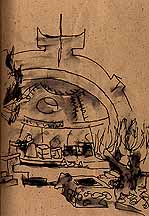
Apse
|
The most novel detail in the design is the “apse”, a south-facing
half-dome in which other units are nestled. The apse allows winter
sun to warm what’s below it, and shades the space in summer. Other
features include removable glazed walls, and cascading waterstairs.
For us the most exciting innovation was a simple temporary whitewashing
of south windows in summer. Why didn’t I think of that? But no
use whatever was made of the persistent wind, except for artnoise. |
The clustered apses and cubicles sit on the brink of a canyon,
facing the sun, and you have to admire the breadth of vision that
lets Soleri see his future city rising above this coyote-run.
The personalized details in decorating this arch illusion are
often molded, painted, and inscribed by the volunteer workers,
which has considerable charm for us admirers of William Morris,
but this democratic creativity often results in a certain amount
of amateur workmanship. Walls and roofs are crumbling and cracking
in places (and the goldfish in the pool are dead). The effect
is rather Mexican, with dubious old construction at one end and
rusted skeletons of the future at the other. Maybe Soleri and
the Mexicans are more interested in process. We rattled out of
Arcosanti wondering if we could entice some young enthusiasts
to build a lawn-ornament factory on the banks of Cathance. Bowdosanti.
North of Arcosanti the land tilted up and onto a high plateau,
and dwarf cedars darkened the slopes and gullies. The scene took
on a mountainous aspect and we crested a height to look down into
the Verde Valley where sedimentary cliff-faces and outcrops shone
yellow-white among the pinkish undertones and coniferous brushcoat.
Having broken our pledge once, it was easy to make another architectural
divergence.
Arizona is a mecca for grand building fantasies. We had bypassed
Taliesen West, where Solari had studied under Frank Lloyd Wright,
and the Biosphere, where sealed futurists are breathing heavily
under a glass dome. But we had sighted numerous domes and spacegrids,
including one extensive cluster of adobe-domed pods in soft pastels.
The regional Buckyness seemed to fit in this bigsky world, where
the stars are loud at night. Now we followed signs to Montezuma’s
Castle, another planned community fitted into the landscape: prehistoric
cliff dwellings.
| Montezuma’s Castle is tucked into a limestone cliff-face up a
side canyon, where the Beaver Creek runs down a stony bed. It
is a simple adobe-brick and stone house-cluster, hanging maybe
100 feet up a sheer wall, under an overhanging ledge. Hardly a
castle. Rather a defensive domicile hidden below a desert plateau.
Beaver Creek is lined with noble sycamores, whose shining white
and mottled trunks, and shivering beige leaves, give the feel
of a New England beech park. We have finally found October, and
the smell of cast leaves. Down here out of the demanding wind
it is balmy, but the overcast moving in is full of rumbling thunder.
A thousand years ago a few families cast their lot here in this
favored spot. Dug irrigation trenches to water their corn. Now
it is a place out of time. |
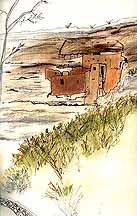
Montezuma's Castle
(Peggy)
|
Then we went farther upcountry into scattered pines and rocky
elevations. Our contacts had directed us to get off the highway
and go through Sedona and up Oak Creek Canyon to Flagstaff. Once
we’d sighted weather-carved scarlet buttes through clefts to the
west, we didn’t need urging. The byway snakes between overshadowing
ramparts of yellow-white limestone until you enter the glowing
panorama of Sedona’s redstones. An uplifting spectacle.
We aren’t the first here, however. In fact we are in a line of
goggleyed autos, many wearing California plates. The valley is
lined with condos, galleries, and architected wonders. The Mercedes
ahead of us pulled into a Century 21 parkinglot. Sedona is another
gallery mart, gift boutiquery, and getaway destination for LA
and Phoenix. Below the $300,000 cottages, jinglebell musak and
waving Santas come out at you from between the Indian blankets
and silver-turquois displays. The gray stratus had clamped down,
setting off the ruddy walls nicely, but promising our first snow,
so we scuttled up the canyon in the waning light.
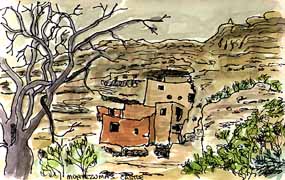
Montezuma's Castle
(Bryce)
|
Glad we did, because the Oak Creek road is a tortuous twist and
turn between exposed stratigrafies of pinks and reds and yellows
and oranges, with an occasional pale green thrown in. There are
windrows and lee piles of old snow chilling us with thoughts of
winter. Down in the streambed below, the boulders are gray and
the thick woods are broadleaved deciduous, now mostly shed, while
the higher slopes are forests of tall ponderosa pines. We are
out of the desert at last.
|
We didn’t actually see enough of Flagstaff to tell you much. We
played bumpercars across its rush-hour, and climbed the mountain
slopes above the city to the last tract development, and the brand
new house of Catherine and John. Indeed, the entire urb seemed
right off the drawing-boards, except for the compressed downtown
district, all strung with Christmas lights and greenery, and with
little snow drifts underfoot. It sure feels strange to encounter
the HoHo season out here on the nether side. Our first Yule bush
was in the lobby of the Grand Baja on a 70 degree Thanksgiving,
and all the familiar folderol has jingled out everywhere since.
There are light displays on the cactus gardens in Tucson, and
Judy’s street is lined with large spherical lights, colored red
and green for the hols. (The blue coyote cutouts do tend to jangle.)
Tempe has wire-framed Christmas-saguaro light displays, and the
commercial beckoning is omnipresent. We made it safely to our
rest without any impulse buying.
John and Catherine are young married folks with a babe-in-arms,
tenure track jobs in the same university, and a new house on a
mountainside. It was warming to be in a happy house with a smiling
future. John is a climber and cyclist, and is in heaven. While
Peggy and Catherine communed about teaching and mutual friends,
he regaled me with yarns about the high Cascades and other peaks
of his acquaintance. My mouth watered for heights unknown, and
for the comestibles in the electric wok. The baby burbled. We
all made it an early night.
In the morn we skied downhill to the interstate junction, and
took a dirt road behind a truckstop, as directed. Immediately
we were in a ponderosa park with a few lowrent encampments. And
there was the described collection of trailers, old vehicles,
and horse pasture. We had found Ruth and Dion’s homestead. Ruth
is a jeweler and Dion a sculptor, and they escaped to Flagstaff
from California a few years back, ahead of the current surge.
In front of the “house” is a 4-foot welded ancient mariner with
an albatross hanging from his neck, and I thought it a powerful
depiction of the artist’s condition. When I put this to Dion,
however, he said, “No. I actually have more fun than that.” And
his work IS fun. His bread-and-butters are playful brazed metal
frogs composed of cannibalized spoons, performing a myriad of
poses. These finance his “more serious” pieces, like his haunting
mariner. We commiserated over the life and laughter, and I felt
we’d found new friends for the long road. We had heard tales of
Dion for years from our mutual friends, including his cousin John,
and our intimacy was sealed by our mutual concern for him. But
the tales we bore couldn’t dampen our pleasure at discovering
kindred spirits hiding out here in the mountains. Different media,
different setting, but the same essentials. Nice, nice, very nice...
Ruth took Peggy out to feed the horse, while Dion pointed out
how they had escaped total destruction by fire. Last year, while
they were away in California doing their summer sales, a forest
blaze swept through the pines around their place, and it was only
saved by aerial chemical bombing and the local fire crew. All
the surrounding trees, though standing, were torched. Some may
survive, that being the pondersa’s fate. The house has chemical
stains all round. It’s a sculptor’s nightmare to lose all his
materials and personal work, but they were spared. We spared them
any more muirisms, and got on the road for Albuquerque.
(Memo #52)
Dec. 5 - Arcosanti by Soleri
Who? Paolo Soleri, an Italian ceramacist-architect
What? a planned community for 4 to 5 thousand people
Where? just north of Phoenix
When? now
How? Arcosanti is supported by the nonprofit Cosanti Foundation
Topics: architecture, intentional communities, Paolo Soleri, archology.
Questions: Can an architect create his own world? How can a unitary
community be built and funded? Can the process of building create
the community?
|
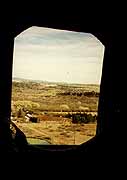
View from Arcosanti
|
Phoenix was the second home of Frank Lloyd Wright; his Taliesin
West was created there as a work-residence center where architects
could develop their visions. One of his acolytes was Paolo Soleri,
an Italian ceramacist-architect who dreams of future integrated
cities of concrete with workplaces and homes, stores and schools
connected and supported by passive solar energy, and food-producing
greenhouses. The first of them - called Arcosanti - is being constructed
north of Phoenix.
Soleri created the term “archology” to describe his vision of
blending architecture and ecology, using sites in the most appropriate
and economical ways. Arcosanti (a planned community for 4-5000
people) is being built on 865 acres north of Phoenix with desert
scrub, mesas and a small river nearby. The site is not far from
the major north-south highway, but is only accessible by its own
washboard dirt road. We bumped along past a sign for “Arcosanti
- an urban laboratory”. A small group of coyotes loped past at
a distance. From a distance you get an impression of a fairly
compact, off-white space colony with domes and arches, juts and
shells that flow along and down the mesa. The cranes on the skyline
show the ongoing construction work.
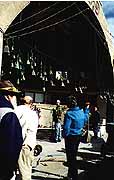
Bells
|
We parked in a small lot and went down pathways and steps to the
visitor center, a five story building at the very edge of the
mesa. The lower stories house the colony cafeteria (serving curries
and vegetarian food) and a bakery. We bought baked goods and went
up several flights to the visitor center. The visitor center has
bronze bells hanging from every projection. Soleri started as
a ceramicist and won a contest with his bronze bells. Both Cosanti
(in Scottsdale) and Arcosanti produce/sell (at quite high prices)
a wide variety of bells which have aesthetic, economic, and spiritual
aims. They are the key product of this community. There are “cause
bells” that are supposed to ring for a specific purpose (peace,
health, etc). The air is full of music at Arcosanti. The center
sells ceramics, T-shirts, posters and a film on Soleri’s work.
We paid the requested donation and had an introduction and tour. |
We saw the model of the full planned community - a portion of
which now exists- with towers and a variety of low clusters of
linked buildings on 25 acres. Soleri incorporates passive solar
heat, designing spaces to be energy efficient, multi-purpose and
in use 24 hours a day. Both prefab and poured-on-site concrete
is used. Heat from the foundry is funneled through surrounding
work and residence spaces. There are a number of passive solar
energy “apses”, the open air concrete shells Soleri uses in a
number of ways (to cover the foundry, to provide a stage area).
They are carefully engineered to use the most sunlight in the
winter and shade during the hottest parts of summer. We got a
simple valuable tip for greenhouse folks - if your space is TOO
hot, simply WHITEWASH THE GLASS TO CUT THE SUNLIGHT. Soleri also
uses moving doors, walls, windows to adapt to changing weather.
There will be a huge expanse of greenhouse ultimately on the mesa
slopes below. There are several large water holding pools and
an orchard and gardens on the canyon floor, but Arcosanti is not
self-supporting.
| We saw the foundry where volunteers were just completing a “pour”
and a number of residential clusters. One that particularly appealed
to me was semi-subterranean, reached by descending a staircase
into a protected courtyard with individual dwellings attached.
Others were two or three story apartments (with a number of bedrooms
and common areas) ranged along long concrete walkways. There is
a huge performance shell used for a music festival and drama events.
There are small courts and lawns and nooks and crannies that appeal
to me. Construction quality varied - some soaring structures are
meticulously built, in another place crumbling concrete shows
a mistake in the mix. Everywhere there are small design details
that show Soleri’s hand - light switches and tiles and handrails,
concrete paving stones and entrance walls all bear his distinct
etched drawing. |
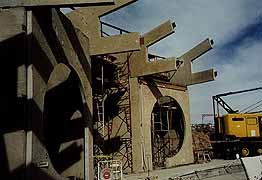
Construction
|
Seventy people now live at Arcosanti, some for short visits, some
settling permanently in apartments and small houses on site and
in a variety of structures off-site. They work in the foundry,
the offices, the cafeteria, the bakery, the studios doing both
Soleri’s work and their own. There are regular six-week workshops
offered which provide paying architecture and art students with
educational credits and hands-on building experiences. The Cosanti
Foundation has full time office employees, and 7 full time architects/
designers/ engineers live here as well. Workshop members live
at Arcosanti and build. Other volunteers come to take part in
the vision; some pour bells, others lead tours. Our guide was
Stephanie, a young woman from Germany who heard of Arcosanti,
came for a short visit, and now has returned for a longer stay.
She gives tours and works in the foundry. We saw people of all
ages there, a grayhaired volunteer in the bakery, teenagers in
the foundry. Volunteers work at Arcosanti and are provided with
living quarters, but must pay for their own food. It seems very
much like 1960’s communes.
| Arcosanti is supported by the nonprofit Cosanti Foundation which
raises money through grants, contributions and sales (primarily
of bells). Soleri currently has large grants from the Guggenheim
and Greyhound Foundations. Soleri has designed huge numbers of
structures and communities, but relatively few have been realized.
He has built two houses in the United States (one of which may
go on the National register), several apses and a ceramics studio
in Italy. He is building three footbridges in Scottsdale. Soleri
is currently involved in the Hyper Building Research Committee,
a Japanese business and government project to create a 1,000 meter
tall mixed-use structure for 300,000 people. Three architects
were asked to submit conceptual designs on a site of their choosing
(Soleri’s is for the Mojave desert!). The plans we saw call for
a huge ground level structure supporting a mammoth tower. Apparently
the three designs will be reviewed in the next year or so. I’m
not sure how many will be built. |
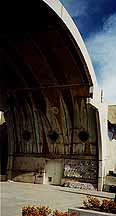
Details
|
Intentional communities in America date back at least to the Pilgrims
(some First Peoples of the Americas had intentional communal societies).
Groups with a vision have architected places to live and work
and worship throughout American history - the Shakers, the Mormons,
the Amana colonies we saw in Iowa. The communities face similar
challenges and changes. When a community has a charismatic leader
like Soleri, whose personality dominates everything, there are
other challenges. How to provide continuity after such a leader
leaves or dies? How to truly cultivate excellence in others? Could
someone else etch a design on a surface at Arcosanti?







